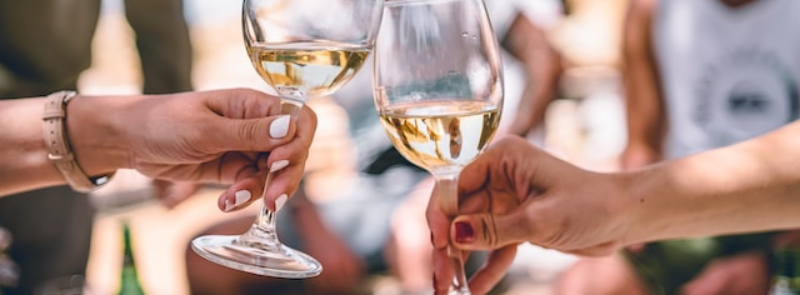
When It Occurs
Every May 25th
Timeline
Days Passed (903)
# Hashtags
#NationalWineDay #WineAndDine
National Wine Day, distinct from the observance of National Drink Wine Day, occurs annually on May 25th in the United States. The essence of this celebration is straightforward – a day dedicated to purchasing wine, expressing gratitude for wine, and reveling in the rich history that spans at least 8,000 years, marking its integral role in human civilization.
Purpose and Significance
National Wine Day offers an opportunity to:
- Celebrate the Art of Winemaking: It recognizes the craftsmanship, history, and culture of winemaking, from ancient times to modern-day wineries.
- Promote the Enjoyment of Wine: Whether it's red, white, rosé, or sparkling, wine lovers across the country celebrate by enjoying their favorite types of wine.
- Encourage Social Gatherings: Wine is often associated with social occasions, and National Wine Day encourages people to gather with friends and family to enjoy the beverage together.
History of Wine
- Ancient Origins: Wine has been produced for thousands of years, with evidence of winemaking dating back to 6000 BCE in regions like Georgia, Iran, and Armenia. It spread to Europe through the Roman Empire, where it became central to culture, religion, and cuisine.
- Wine in the U.S.: In America, wine production has flourished since the European settlers introduced grapevines. California, in particular, became a leading region for wine production, with Napa Valley gaining worldwide fame.
Wine Varieties
There are numerous types of wine, each with distinct flavors, aromas, and characteristics. Some of the most popular varieties include:
- Red Wine: Known for its rich and bold flavors, red wine is made from dark-colored grape varieties. Common types include Cabernet Sauvignon, Merlot, Pinot Noir, and Zinfandel.
- White Wine: Typically lighter and crisper, white wines are made from green or yellow grapes. Popular varieties include Chardonnay, Sauvignon Blanc, and Riesling.
- Rosé Wine: Rosé is made from red grapes but has less contact with the grape skins, giving it a pink hue and a lighter flavor profile.
- Sparkling Wine: Bubbly wines like Champagne and Prosecco are made through a secondary fermentation process that traps carbon dioxide, creating the characteristic fizz.
- Dessert Wines: Sweet wines like Port, Sherry, and Moscato are often enjoyed as dessert accompaniments.
Ways to Celebrate National Wine Day
-
Visit a Winery: If you're near a wine-producing region, National Wine Day is the perfect occasion to visit a winery, take a tour, and sample different wines. Many wineries host special events or offer tastings on this day.
-
Host a Wine Tasting: Invite friends or family to participate in a wine-tasting event. You can sample different varieties of wine, discuss the flavors, and learn more about each type.
-
Pair Wine with Food: Explore food and wine pairings by trying different wines with complementary dishes. For example, red wine pairs well with red meats, while white wine goes well with fish and poultry.
-
Try a New Wine: If you’re stuck in a wine rut, use National Wine Day as an opportunity to try something new. You might discover a new favorite variety or brand.
-
Learn More About Wine: National Wine Day is also an educational opportunity. You can learn about the winemaking process, different wine regions, and the history of wine by reading books, watching documentaries, or attending wine seminars.
Fun Facts About Wine
-
World's Oldest Winery: The oldest known winery, dating back to around 4100 BCE, was discovered in the Areni Cave in Armenia.
-
Wine and Health: In moderation, wine, particularly red wine, is often associated with health benefits due to its antioxidants, which may promote heart health.
-
Wine Regions: The world’s major wine-producing regions include France, Italy, Spain, the United States (particularly California), and Australia.
-
Types of Grapes: There are over 10,000 grape varieties used for winemaking, though only a small percentage are commonly known.
Wine Etiquette
If you're participating in a wine event or tasting, there are some general etiquette tips to follow:
- Hold the glass by the stem: This prevents your hand from warming the wine.
- Swirl the wine: Swirling helps release the wine's aromas.
- Smell the wine: A large part of the wine-tasting experience is smelling the wine to identify its various notes.
- Taste the wine: Take small sips and allow the wine to linger in your mouth to appreciate its flavors fully.
National Wine Day vs. Other Wine Days
It’s worth noting that there’s also a National Drink Wine Day, which is celebrated on February 18. While both days celebrate wine, National Wine Day (May 25) tends to emphasize the broader appreciation of wine, including its culture, production, and history, while National Drink Wine Day is more focused on simply enjoying the beverage.
Social and Economic Impact of Wine
-
Economic Contributions: The U.S. wine industry contributes billions of dollars to the national economy through jobs, tourism, and exports. Napa Valley and Sonoma County in California are two of the most famous wine-producing areas in the world.
-
Tourism: Wine tourism, or "wine tourism," is a significant part of the U.S. travel industry. People travel to regions like California, Oregon, and Washington to visit vineyards, taste wines, and explore scenic landscapes.
-
Wine Culture: In the U.S., wine has evolved from a luxury beverage to something enjoyed across all walks of life. Wine clubs, tasting events, and wine bars have become part of mainstream culture, contributing to its widespread appeal.
Interesting Trivia About Wine
-
Age Matters: Some wines improve with age, while others are best consumed soon after production. Red wines, in particular, are known for aging well.
-
Wine Legs: When you swirl wine in a glass, the liquid may cling to the sides and form "legs" or "tears." This phenomenon is due to the alcohol content and viscosity of the wine and is often mistakenly used as a sign of quality (it's not).
-
Champagne vs. Sparkling Wine: All Champagne is sparkling wine, but not all sparkling wine is Champagne. To be called Champagne, the wine must come from the Champagne region of France and follow strict production methods.
Conclusion
National Wine Day is a celebration for wine enthusiasts, offering the perfect excuse to savor a glass (or two) of wine, discover new varieties, and explore the rich history of one of the world’s most beloved beverages. Whether you’re attending a winery, hosting a tasting, or just enjoying a quiet evening with your favorite bottle, this day is all about enjoying and appreciating wine in all its forms.


